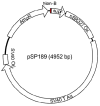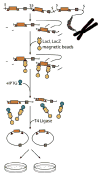Methods to determine DNA structural alterations and genetic instability
- PMID: 19245837
- PMCID: PMC2693251
- DOI: 10.1016/j.ymeth.2009.02.012
Methods to determine DNA structural alterations and genetic instability
Abstract
Chromosomal DNA is a dynamic structure that can adopt a variety of non-canonical (i.e., non-B) conformations. In this regard, at least 10 different forms of non-B DNA conformations have been identified; many of them have been found to be mutagenic, and associated with human disease development. Despite the importance of non-B DNA structures in genetic instability and DNA metabolic processes, mechanisms by which instability occurs remain largely undefined. The purpose of this review is to summarize current methodologies that are used to address questions in the field of non-B DNA structure-induced genetic instability. Advantages and disadvantages of each method will be discussed. A focused effort to further elucidate the mechanisms of non-B DNA-induced genetic instability will lead to a better understanding of how these structure-forming sequences contribute to the development of human disease.
Figures





Similar articles
-
Non-B DNA structure-induced genetic instability and evolution.Cell Mol Life Sci. 2010 Jan;67(1):43-62. doi: 10.1007/s00018-009-0131-2. Epub 2009 Sep 1. Cell Mol Life Sci. 2010. PMID: 19727556 Free PMC article. Review.
-
Non-B DNA structure-induced genetic instability.Mutat Res. 2006 Jun 25;598(1-2):103-19. doi: 10.1016/j.mrfmmm.2006.01.019. Epub 2006 Mar 3. Mutat Res. 2006. PMID: 16516932
-
Models for chromosomal replication-independent non-B DNA structure-induced genetic instability.Mol Carcinog. 2009 Apr;48(4):286-98. doi: 10.1002/mc.20508. Mol Carcinog. 2009. PMID: 19123200 Free PMC article. Review.
-
Non-B DNA structures as a booster of genome instability.Biochimie. 2023 Nov;214(Pt A):176-192. doi: 10.1016/j.biochi.2023.07.002. Epub 2023 Jul 8. Biochimie. 2023. PMID: 37429410 Review.
-
Impact of alternative DNA structures on DNA damage, DNA repair, and genetic instability.DNA Repair (Amst). 2014 Jul;19:143-51. doi: 10.1016/j.dnarep.2014.03.017. Epub 2014 Apr 21. DNA Repair (Amst). 2014. PMID: 24767258 Free PMC article. Review.
Cited by
-
Distinct DNA repair pathways cause genomic instability at alternative DNA structures.Nat Commun. 2020 Jan 13;11(1):236. doi: 10.1038/s41467-019-13878-9. Nat Commun. 2020. PMID: 31932649 Free PMC article.
-
Non-B DNA structure-induced genetic instability and evolution.Cell Mol Life Sci. 2010 Jan;67(1):43-62. doi: 10.1007/s00018-009-0131-2. Epub 2009 Sep 1. Cell Mol Life Sci. 2010. PMID: 19727556 Free PMC article. Review.
-
Topoisomerase I plays a critical role in suppressing genome instability at a highly transcribed G-quadruplex-forming sequence.PLoS Genet. 2014 Dec 4;10(12):e1004839. doi: 10.1371/journal.pgen.1004839. eCollection 2014 Dec. PLoS Genet. 2014. PMID: 25473964 Free PMC article.
-
Detection of cis- and trans-acting Factors in DNA Structure-Induced Genetic Instability Using In silico and Cellular Approaches.Front Genet. 2016 Aug 2;7:135. doi: 10.3389/fgene.2016.00135. eCollection 2016. Front Genet. 2016. PMID: 27532010 Free PMC article.
-
Effects of Replication and Transcription on DNA Structure-Related Genetic Instability.Genes (Basel). 2017 Jan 5;8(1):17. doi: 10.3390/genes8010017. Genes (Basel). 2017. PMID: 28067787 Free PMC article. Review.
References
-
- Wells RD. Trends Biochem Sci. 2007;32:271–278. - PubMed
-
- Lander ES, Linton LM, Birren B, Nusbaum C, Zody MC, Baldwin J, Devon K, Dewar K, et al. Nature. 2001;409:860–921. - PubMed
-
- Schroth GP, Chou PJ, Ho PS. J Biol Chem. 1992;267:11846–11855. - PubMed
-
- Catasti P, Chen X, Mariappan SV, Bradbury EM, Gupta G. Genetica. 1999;106:15–36. - PubMed
-
- Djian P. Cell. 1998;94:155–160. - PubMed
Publication types
MeSH terms
Substances
Grants and funding
LinkOut - more resources
Full Text Sources

